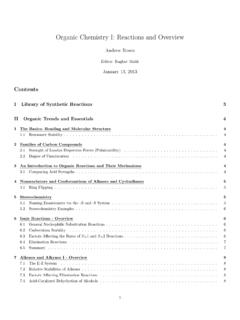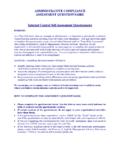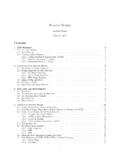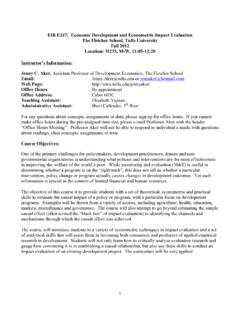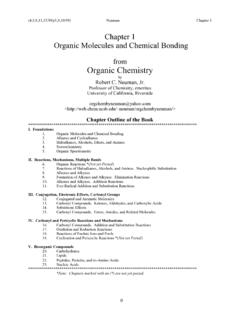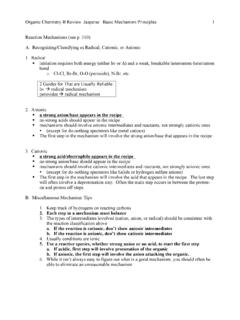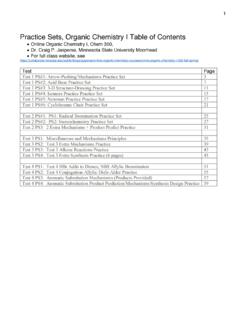Transcription of Organic Chemistry I: Reactions and Overview - Tufts University
1 Organic Chemistry I: Reactions and Overview Andrew Rosen Editor: Raghav Malik January 13, 2013. Contents I Library of Synthetic Reactions 3. II Organic Trends and Essentials 4. 1 The Basics: Bonding and Molecular Structure 4. Resonance Stability .. 4. 2 Families of Carbon Compounds 4. Strength of London Dispersion Forces (Polarizability) .. 4. Degree of Unsaturation .. 4. 3 An Introduction to Organic Reactions and Their Mechanisms 4. Comparing Acid Strengths .. 4. 4 Nomenclature and Conformations of Alkanes and Cycloalkanes 5. Ring Flipping .. 5. 5 Stereochemistry 5. Naming Enantiomers via the -R and -S System .. 5. Stereochemistry Examples .. 6. 6 Ionic Reactions - Overview 6. General Nucleophilic Substitution Reactions .. 6. Carbocation Stability .. 6. Factors A ecting the Rates of SN 1 and SN 2 Reactions .. 6. Elimination Reactions .. 7. summary .. 7. 7 Alkenes and Alkynes I - Overview 8. The E-Z System .. 8. Relative Stabilities of Alkenes.
2 8. Factors A ecting Elimination Reactions .. 8. Acid-Catalyzed Dehydration of Alcohols .. 8. 1. III Reaction Mechanisms 9. 8 Ionic Reactions - Mechanisms 9. The SN 2 Reaction .. 9. The SN 1 Reaction .. 10. The E2 Reaction .. 10. The E1 Reaction .. 11. 9 Alkenes and Alkynes I - Mechanisms 11. Acid-Catalyzed Dehydration of Secondary or Tertiary Alcohols: An E1 Reaction .. 11. Acid-Catalyzed Dehydration of Primary Alcohols: An E2 Reaction .. 12. Synthesis of Alkynes from Vic-Dihalides .. 12. Substitution of the Acetylenic Hydrogen Atom of a Terminal Alkyne .. 12. Deprotonation Reagents .. 12. Hydrogenation .. 13. 10 Alkenes and Alkynes II - Mechanisms 13. Addition of H X to an Alkene .. 13. Acid-Catalyzed Hydration of an Alkene .. 13. Mercuration-Demercuration and Hydroboration-Oxidation .. 13. summary of H X and H OH Additions .. 14. Electrophilic Addition of Bromine and Chlorine to Alkenes .. 14. Halohydrin Formation from an Alkene .. 15.
3 Oxidative Cleavage of Alkenes .. 15. OsO4 Reaction .. 15. summary for Dihalide, Dihydroxy, and Carbene Additions .. 16. Electrophilic Addition of Bromine and Chlorine to Alkynes .. 16. Addition of Hydrogen Halides to Alkynes .. 16. Oxidative Cleavage of Alkynes .. 16. 11 Alcohols and Ethers - Mechanisms 16. Alcohols with H X .. 16. Alcohols with PBr3 or SOCl2 .. 17. Leaving Group Derivatives of Alcohols .. 17. Converting OH to LG summary .. 17. Synthesis of Ethers .. 17. Protecting Groups .. 18. Ether Reactions summary .. 18. Epoxides .. 18. Epoxide Reaction summary with Example .. 19. 12 Alcohols from Carbonyl Compounds - Mechanisms 19. Alcohols by Reduction of Carbonyl Compounds .. 19. Oxidation of Alcohols .. 19. Alcohols from Grignard Reagents .. 19. 13 Radical Reactions - Mechanisms 20. Bromination .. 20. Chlorination .. 20. 2. Part I. Library of Synthetic Reactions 1. Note that this is a partial list of Reactions 1 Graphics are obtained mostly from Stony Brook University CHE 327 PowerPoint slides and Organic Chemistry , 10th Edition by Solomons and Fryhle.
4 3. Part II. Organic Trends and Essentials 1 The Basics: Bonding and Molecular Structure Resonance Stability 1. The more covalent bonds a structure has, the more stable it is 2. Charge separation (formal charges) decreases stability 3. Negative charges on the more electronegative elements and positive charges on the more electropositive elements are more favorable 2. 2 Families of Carbon Compounds Strength of London Dispersion Forces (Polarizability). 1. Large atoms are easily polarizable and small atoms are not 2. Atoms with unshared electron pairs are more polarizable than atoms with only bonding pairs 3. Molecules that are longer and atter ( long chains ) have more surface area and thus have larger dispersion forces when other factors are similar Degree of Unsaturation A degree of unsaturation is either a bond or a ring structure 2C + 2 + N H X. Formula: where the variables are the number of carbons (C), nitrogens (N), hydrogens (H), and 2.
5 Halogens (X). 3 An Introduction to Organic Reactions and Their Mechanisms Comparing Acid Strengths Factors A ecting Acidity (in decreasing signi cance) : ARIO. 3. 1. Atom 2. Resonance Stabilization 3. Induction E ect 4. Orbital (s character). 2 For the purposes of drawing all resonance structures, it is not considered a violation of the octet rule if a second-row element, like carbon, has fewer than an octet. It is less likely but still imperative to draw. 3 This general trend is not always perfectly applicable. However, it is usually a fairly good indicator. 4. ARIO Explained: Atom: Look at what atom the charge is on for the conjugate base. For atoms in the same row, we consider electronegativity. The further to the right on the periodic table an atom is, the more electronegative it is. If a conjugate base's negative charge is on a more electronegative atom, it is more stable, and thus the parent acid is stronger. For atoms in the same column, we consider an atom's ability to stabilize a charge.
6 The further down on the periodic table an atom is, the better it is at stabilizing a charge. If a conjugate base's negative charge is more stabilized on an atom further down a group, it is a more stable molecule, and thus the parent acid is stronger. Resonance Stabilization: Look at resonance structures. The more distributed the charge of the conjugate base is, the stronger the parent acid is. Inductive E ect: Look for inductive e ect. If there are many electronegative atoms near the conjugate base's negative charge, electron density is pulled toward these atoms. This creates more stable anions and thus more acidic parent molecules. However, if there are many alkyl groups, this is a process called hyperconjugation, and the parent acid is actually less stable. Orbital: Look at the orbital where the negative charge for the conjugate base is. More s character of a bond with hydrogen makes it more acidic. 4 Nomenclature and Conformations of Alkanes and Cycloalkanes Ring Flipping The axial groups become equatorial and vice versa When doing a ring ip, whether a group is up or down does not change Chair Conformation 1: Chair Conformation 2 (after ring ip): When performing a chair ip, each atom is rotated one spot in the clockwise direction A molecule is more stable when steric hindrance is minimized and bulky substituents are equatorial as opposed to axial 5 Stereochemistry Naming Enantiomers via the -R and -S System 1.
7 Each of the four groups attached to the chirality center is assigned a priority of 1, 2, 3, or 4. Priority is assigned on the basis of the atomic number of the atom that is directly attached to the chirality center. The group with the highest atomic number gets the highest priority and vice versa. 2. When a priority cannot be assigned on the basis of atomic number of the atoms, then the next set of atoms in the unassigned groups is examined. This process is continued until a decision can be made at the rst point of di erence. 5. (a) Step 1: Step 2: 3. If the 4th atom is a dashed wedge (downward): Analyze if the numbers (1 2 3 4) go clockwise or counterclock- wise. Clockwise indicates that the molecule is R, while counterclockwise indicates the molecule is S.. 4. If the 4th atom is a solid wedge (upward): Analyze this intermediate molecule to see if the numbers go clockwise or counterclockwise. Clockwise indicates that the original molecule is S, while counterclockwise indicates the molecule is R.
8 Stereochemistry Examples 6 Ionic Reactions - Overview General Nucleophilic Substitution Reactions A deprotonation step is required to complete the reaction when the nucelophile was a neutral atom that bore a proton Example showing deprotonation : 4. Carbocation Stability Order of Carbocation Stability: 3 > 2 > 1 > Methyl Factors A ecting the Rates of SN 1 and SN 2 Reactions Simple alkyl halides show the following trend for order of reactivity in SN 2 Reactions : Methyl > primary > secondary (tertiary-unreactive). 4 Deprotonation is normally seen as H3 O+ in water, but when there is a di erent solvent in excess it will be di erent 6. The rates of SN 2 Reactions (not SN 1) depend on both the concentration and identity of the attacking nucleophile In a selection of nucleophiles in which the nucleophilic atom is the same, nucleophilicities parallel basicities: RO > HO RCO . 2 > ROH > H2 O. Nucleophiles parallel basicity when comparing atoms in the same period Nucleophiles do not parallel basicity and, instead, parallel size when comparing atoms of the same group The best leaving groups are weak bases after they depart Polar aprotic solvents favor SN 2 and polar protic solvents favor SN 1.
9 Most of the solvents with abbreviated names are polar aprotic Elimination Reactions Higher temperatures increase the rates of elimination Reactions A product with a more substituted double bond is more stable and thus more favorable If tert-butoxide is used, sterics must be considered to nd out which hydrogen it takes through the E2 reaction summary Note: It is debatable, but secondary molecules can have SN 1 or E1 in polar protic solvents 7. 7 Alkenes and Alkynes I - Overview The E-Z System To determine E or Z , look at the two groups attached to one carbon atom of the double bond. Decide which has higher priority. Then, repeat this at the other carbon atom. If the two groups of higher priority are on the same side of the double bond, the alkene is designated Z. If the two groups of higher priority are on opposite sides of the double bond, the alkene is designated E. Relative Stabilities of Alkenes The trans isomer is generally more stable than the cis isomer The greater number of attached alkyl groups, the greater the stability of an alkene Factors A ecting Elimination Reactions A non-bulky base favors the more substituted double bond while a bulky base favors in making the less substituted double bond Acid-Catalyzed Dehydration of Alcohols Rearrangements, also known as 1,2 shifts, can occur in primary and secondary alcohol dehydration The more favored product is dictated by the stability of the alkene being formed For dehydration of secondary alcohols, the positive charge is shifted through a hydride shift or alkyl shift For the dehydration of primary alcohols, a carbocation is not formed as an intermediate.
10 However, rearrangements can still occur after dehydration. The resulting alkene's bond is broken when a hydrogen atom from the acid bonds to the carbon to form a carbocation. Rearrangement then occurs as usual. A ring can change in size due to a methyl shift, especially to reduce ring strain. An example is shown below: Note: Never do two migrations 8. Part III. Reaction Mechanisms 8 Ionic Reactions - Mechanisms The SN 2 Reaction Occurs with inversion of con guration If the bond to a chirality center is broken, there is an inversion of stereochemistry 9. The SN 1 Reaction An SN 1 reaction will cause racemization if enantiomers are possible products The E2 Reaction There must be an anti-coplanar nature 10. The E1 Reaction E1 Reactions almost always accompany SN 1 Reactions to some extent 9 Alkenes and Alkynes I - Mechanisms Acid-Catalyzed Dehydration of Secondary or Tertiary Alcohols: An E1 Reaction 11. Acid-Catalyzed Dehydration of Primary Alcohols: An E2 Reaction Synthesis of Alkynes from Vic-Dihalides Alkynes can be synthesized from alkanes via compounds called vicinal dihalides, which are compounds bearing the halogens on adjacent carbons It requires the use of NH.
